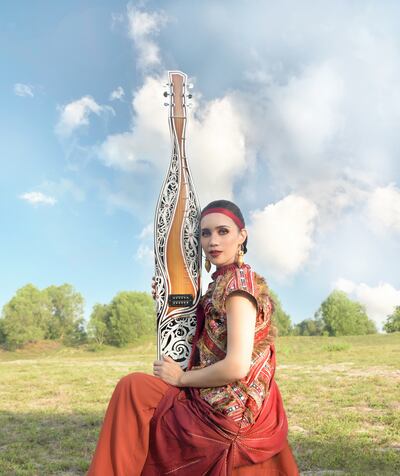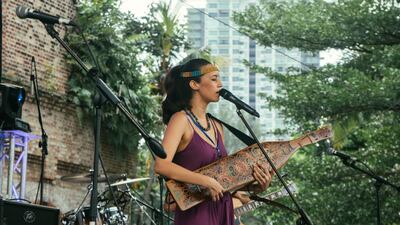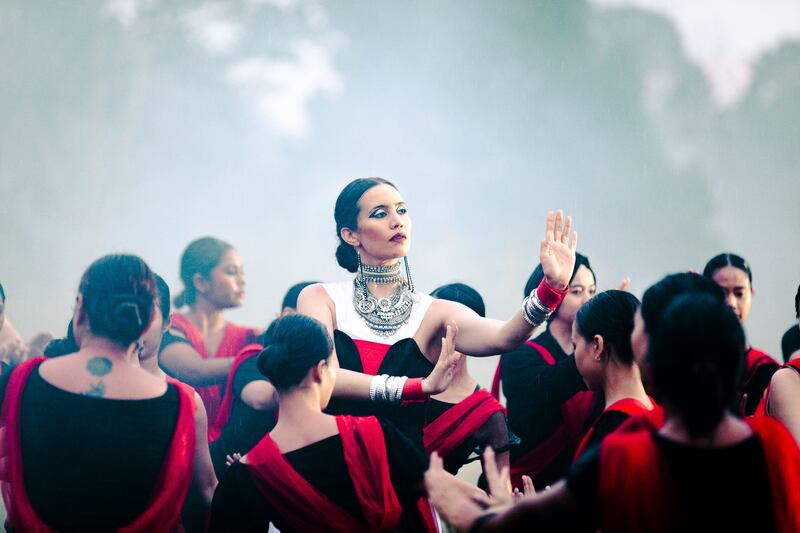Dayaks, the indigenous people of Borneo, which is the largest island in Asia, were once known for their headhunting, animal sacrifices, ceremonial tattoos and warrior costumes.
But there is more to the Dayaks than these erstwhile practices. With about 50 ethnic groups and endemic languages, they have a rich heritage of art and culture not many are familiar with. To rectify that, Alena Murang, 32, a singer from Kuala Lumpur, has been showcasing the indigenous music of her community to the world.
Through her numerous singles and albums, such as Sky Songs and Flight, with tracks in Kelabit and Kenyah, the endangered tribal languages of Borneo, Murang continues to preserve and shine a light on the musical legacy of Sarawak, a state in Malaysian Borneo. She is the first professional female sape player and teacher in Malaysia.
Murang's sape plays the central character in her music video Warrior Spirit, while the drums and the guitar play a supporting role. Lilting and uplifting, you can get hooked on the music of the sape, as she and other dancers sway gracefully to the hornbill and warrior dance steps. The video went on to win Best Asia & Pacific Music Video, and received an Honourable Mention for Best Costume, at the UK's International Music Video Awards this year. It also bagged awards at the New York International Film Awards, Rome International Movie Awards and Los Angeles Film Awards.
Along with local band Estranged, Murang is now working on a documentary series, Roads to Our Heritage. The project aims to showcase the traditional instrument makers of the states of Sabah and Sarawak to the world. And judging by the popularity she has garnered in such a short time, it looks like she is on the right track.
A traditional lute, the sape is a musical instrument played by the Kenyah and Kelabit people who live in the longhouses of Sarawak. Being born to a Kelabit father and a half-English, half-Italian anthropologist mother ensured Murang stayed close to her Sarawakian roots as a child.
"My mother pushed me to learn our traditional dance at the cultural foundation when I was 6," Murang tells The National. "I learnt the basics of the different indigenous groups. When I turned 9, I left the cultural foundation and learnt dance from my Kelabit aunties along with my boy and girl cousins."
While the boys practised the warrior dance, the girls learnt to dance the hornbill – the curved-beak bird is the state symbol of Sarawak and is considered auspicious.

These fun-filled classes set the tone for Murang's sape journey. "There weren't many live sape players then who would play for us, and there was only one commercially available sape album by the late master Tusau Padan to practise to," says Murang. "It came out of a creative need – if we could play sape for our dances, we could change the rhythm, make the tracks longer or shorter."
The mothers of these children realised there was hardly anyone from Murang's generation playing the instrument. It was not accessible to girls. By the time Murang turned 11, she had stopped taking dance classes and focused on learning the sape.
Murang took classes from the famed Kenyah sape player Mathew Ngau Jau in Kuching, the Sarawak capital, until she finished high school. She then moved to the UK to study business management for five years. She took her saxophone, guitar and sape with her and played at events such as the Malaysia Nights and Malaysia Exhibition in London.
"I never thought it was possible to be a professional sape player then," she says.
After completing her education, she moved to Kuala Lumpur and took a job in management consulting for the sustainability sector, and then a visual arts course in Singapore. When she returned, she joined a world music band made up of her ex-colleagues from business management to play the sape on a six-week tour of the US in 2014. Murang noticed people were curious about the instrument as they had never seen one before. The tour turned out to be life-altering, and Murang found her calling.
"I realised people are interested in our music, and there is so much to share," she says. "When I was in the UK, I missed the Malaysian culture, the music, costumes and food. Being away from Sarawak in the US and the UK made me realise how special we are; our stories are, and how much people are interested."
By 2016, she became a full-time sape player and began to conduct classes in it, too.

Traditionally made from a single bole of wood, elaborate Dayak motifs adorn the stringed instrument. "A decade back, the contemporary six-stringed sape, played like a guitar, arrived on the musical scene," explains Murang. But she prefers strumming the four-stringed traditional sape with her thumb.
"The sape is easy to learn, but to master it, it takes about eight years. We don't learn with notes, as it is intuitive. In recent times people have developed a notation system, but you cannot notate it completely. It requires a lot of improvisations that cannot be taught and demands listening."
An instrumentalist until 2016, Murang also took to singing on various platforms in the past few years. "Back then, it was my aunties and my mother who pushed us [to learn] the traditional songs," she says. "I have been making an effort to learn different songs from different grand aunties."
Like her ancestors, Murang draws inspiration from various elements of nature – the sky, river, rain, wind, stars, moon and rainforests told through stories. Heavily doused with a feeling of yearning and doses of nostalgia, her songs take you to her home and her roots. The sape transcends in every track of hers as she narrates tales of her land.





